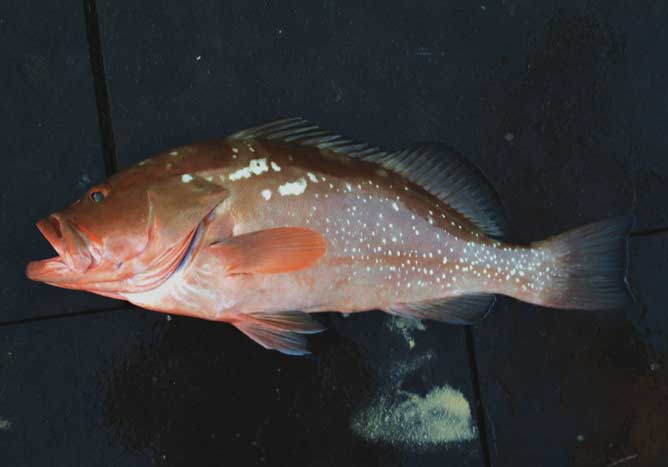Epinephelus morio (SEFSC Pascagoula Laboratory; Collection of Brandi Noble, NOAA/NMFS/SEFSC ) Cladus: Eukaryota Vernacular names The red grouper (Epinephelus morio) is a species of fish in the Serranidae family. It is found in Anguilla, Antigua and Barbuda, Aruba, the Bahamas, Barbados, Belize, Bermuda, Brazil, Cayman Islands, Colombia, Costa Rica, Cuba, Dominica, the Dominican Republic, French Guiana, Grenada, Guadeloupe, Guatemala, Guyana, Haiti, Honduras, Jamaica, Martinique, Mexico, Montserrat, Netherlands Antilles, Nicaragua, Panama, Puerto Rico, Saint Kitts and Nevis, Saint Lucia, Saint Vincent and the Grenadines, Suriname, Trinidad and Tobago, Turks and Caicos Islands, the United States, Venezuela, the British Virgin Islands, and the U.S. Virgin Islands. Its natural habitats are open seas, shallow seas, subtidal aquatic beds, coral reefs, rocky shores, sandy shores, estuarine waters, intertidal flats, intertidal marshes, coastal saline lagoons, coastal freshwater lagoons, and karsts. The Red Grouper is an opportunistic feeder and a top predator in the reef community. The diet is varied but commonly includes lutjanid and sparid fishes, xanthid and portunid crabs, spiny lobster, and snapping shrimp. The Red grouper is of moderate size, about 125 cm and weighs 23 kg or more Body coloration is typically reddish-brown color. White spots are commonly found on the body of the red grouper. Red grouper are unique in the fact that they are protogynous hermaphrodites, beginning life as females, with some later transforming into males. Females transform into males between the ages of 7 and 14.Spawning occurs between January and June, peaking in May. Red Grouper are mostly batch spawners. Larval red grouper leave the plankton after approximately 1 month. Garcia-Moliner & G., Eklund, A-M. 2004. Epinephelus morio. 2006 IUCN Red List of Threatened Species. Downloaded on 4 August 2007. Florida Dept. of Natural Resources, Marine Research Laboratory. Biology of the Red Grouper Epinephelus Morio (Valenciennes). Florida Dept. of Natural Resources, Marine Research Laboratory, 1969. Print.
Source: Wikipedia, Wikispecies: All text is available under the terms of the GNU Free Documentation License |
|

